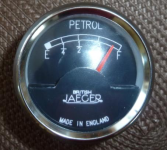A very clever guy in Germany called Declan Burns has a small business making and supplying MG parts. I have purchased a novel electronic fuel sender unit that works on the hydrostatic principle. The system has yet to be tested but I an hopeful because the quality of his products is the highest anywhere.
MG T-Series Fuel level gauge.

This is a hydrostatic level sensor which connects into the fuel tank drain plug via a three way ball valve. The installation of the ball valve adds a user friendly drain facility. The arrangement at the bottom of the tank is shown in fig 1.
Fig 1. Installation arrangement


1) The sensor fig 2
The sensor is a hydrostatic fuel sensor-made in the EU. It has four buttons, a trim potentiometer and an LED for calibration. Connection to the dashboard via a Molex connector (supplied). Connection to the ball valve via a brass pressure port.
The function of the buttons is:
Set gauge min
Set gauge max
Set level empty
Set level full

An initial calibration may be carried out with a 1 1⁄2 litre bottle of water on the bench. The details on this are given in the operating manual. Fuel density (DIN 228) is 720 to 775 kg/m3 or roughly 3⁄4 the density of water. Therefore 33cm water corresponds roughly to a full tank (43cm) of fuel.
2) The gauge
The sensor may be connected to a standard fuel gauge e.g.240 ... 33 Ohms empty to full.
(Also tested on a 10 ... 90 Ohms empty to full.). Originally, the T-Series was never fitted with a fuel gauge... it was time for a reincarnation!.
Fig 3.(Example)
I have had a 52mm gauge built by 'British Jaeger' owner John Marks which has a more period looking dial face. The scale is non linear in an attempt to compensate for the shape of the tank.
Fig 3

3) Connection
The gauge and the sensor require a +12V ... 0V connection. This is not an issue on cars that have been converted to negative earth. On cars that have the original positive earth, it is easy enough to make an isolated floating negative earth supply via the switched ignition using automotive relays. The details are shown on the cable harness wiring diagram provided. The actual length of cable required depends on the preferred routing of the cable. Approx. 4m (12ft) of cable harness is sufficient. The harness can be covered with polyester cable braid for protection. The corresponding Molex plugs and pins are included in the kit and will require crimping with a pliers. The wiring cable is not provided but specified.
Installing this system as recommended does require carefully drilling a 52mm hole in the dashboard (which is not what every owner wants to do but with my re-designed dash I am relaxed about it.)
Installation issues
The drain plug is slightly lower than the gauze filter on the fuel line. it may be advisable to fit an inline filter between gauge and sensor-see Fig 5. This has been tested and should does not affect the hydrostatic pressure.
Make sure there is no air trapped in the fuel hose between the sensor and the ball valve. This will lead to false readings if not bled correctly. It is best to fill a little fuel in the tank then fill the hose and sensor with fuel in the vertical position, open the ball valve very slightly so fuel just drops out and into a bucket placed under the ball valve. Then quickly fit the hose to the ball valve. It is also recommended to keep the fuel hose as short as possible. It is also imperative to make sure that the fuel filler cap is sufficiently vented.


Fig 5 Installation with filter. The handle on the ball valve was removed on this installation.


+++++++++++++++++++++++++++++++++++++++++++++++++++++++++++++++++++++++++++++++++
I have also fitted a low oil pressure sender/warning kit :
Despite the provision of an oil pressure gauge, a sudden loss of oil pressure can easily go unnoticed and prove expensive.! Better safe than sorry, I am intending to fit a warning light and buzzer.
The kit consists of a brake pressure adapter which allows a 'T' piece to be fitted in the pressure gauge line and a pre wired relay module mounted in a plastic case that can be fitted behind the dashboard. The kit also includes the wiring from the pressure switch to the relay module and the wire for the power supply including 2A fuse and buzzer.
A warning light can be suppled but I have today ordered a red dash warning light from Octagon spares to match and compliment the existing warning lights.
According to Declan

(edit)
"When the ignition is switched on the buzzer is off and receives an operation permissive once the engine has been started and the oil pressure exceeds 20 psi. The buzzer going off every time the ignition is switched on would prove annoying. A test switch is fitted to the circuit to enable the buzzer to be tested. This is how it the system works:
Ignition ON & engine OFF, (no oil pressure),
warning light is ON and buzzer is OFF.
Start engine. When the pressure reaches 20psi the warning light goes OFF, and Buzzer remains OFF.
With engine ON & pressure drops below 20 psi, the warning light and buzzer come ON.
The warning light and buzzer stay on until reset by switching off the ignition.
This circuit is not polarity sensitive and is designed for cars with positive or negative earth.
* Other pressure switches other than 20psi are available. When ordering remember to tell me the value of your hot idle oil pressure."



































 )
)





























